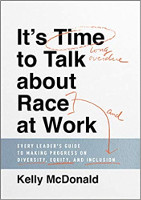
Image by Venita Oberholster
Narrated by Pam Atherton.
Watch video version on InnerSelf.com or on YouTube
Respect is profoundly meaningful, but costs nothing to give. Here are ways you can demonstrate (and model) respect for your diverse coworkers, regardless of who they are or what their positions are within your organization:
1. Listen without interruption, arguing, or defensiveness.
This may be the most important—and easiest—thing you can do. When working with people who are different from you, actively listening to their ideas, feedback, thoughts, or concerns conveys tremendous respect. Give them your full attention and let them finish speaking before you comment or ask a question.
2. Ask questions.
Questions are respectful because they encourage someone to share their opinions, ideas, and input. When talking with team members, particularly about difficult subjects such as race or inequity at work, we are often uncomfortable asking questions, because we don’t know where the answer will lead. And we’re uncomfortable with the conversation as a whole, so we sure don’t want to prolong it by asking questions—we just want it over with!
But asking questions such as “Can you tell me more about that idea?” or “What are the obstacles we need to identify to address this?” or “What do you think is the best way to proceed?” are not only viable, they also convey that you’re committed. You’re in this, and you’re not afraid to learn more.
3. Honor their experience, instead of discounting it.
Whether it’s professional experience or life experience, your diverse team comes to the table with experience you probably don’t have. It could be very positive experience, but it may not be, and it’s important to acknowledge their experience, regardless of whether you can relate to it or fix it.
For example, my friend Tasha is a Black woman who worked in a warehouse when she was in her twenties. She was the only woman on the team, the only Black person on the team, and the only one in her twenties. All the guys were White and had at least ten more years of experience. She wasn’t harassed in an overt way, but the team found ways to put her down or dismiss her capabilities. When she would bring up an issue or problem she’d come across, the guys would say things like, “Don’t you worry about that, missy—just finish the report and leave the problems to us.”
She felt she wasn’t learning and growing much in that role, so she resigned and took another job. On her first day in her new job, her manager met with her for an hour and asked her in-depth questions about her past experiences, saying, “We are so excited about having you on our team. The first thirty days in any new job are a big learning curve, and I want to get you off to a strong start. I’d like you to tell me about how you learn best, what blocks progress for you, and what support I can provide that will be helpful to you in the next thirty days.” Wow! What a great “first day on the job” conversation! Anyone would feel supported and respected and valued with a conversation like that!
With that foundation of respect and trust, from day one, Tasha felt comfortable and safe to share her experiences from her previous job, good and bad. And her manager had a better understanding of what would help her be successful from the start. Tasha and her boss enjoyed a fabulous working relationship for more than a decade and she credits him with showing her exactly how to demonstrate respect and support for an employee.
4. Validate their contributions.
We all like to be recognized for our contributions at work. It feels good to have others comment on our work, our commitment, and our expertise or experience. By validating a coworker’s contribution, you show respect for their efforts—and the outcome.
Jonah is an IT professional at a large manufacturing company. In manufacturing, production equals money and downtime equals lost money. When the company went through a major software and systems upgrade, he worked for six weeks straight without a single day off to ensure that the upgrade process went smoothly and the manufacturing pace continued without interruption.
His boss not only congratulated him on the success of the installation, but also praised him in an email to the entire company. Jonah was also invited to a meeting with the company’s top executives, where they thanked him for his tireless efforts and his dedication to making sure the manufacturing process continued uninterrupted. You can imagine how good Jonah felt about his work and the respect his company and his boss showed him for his contribution.
You don’t have to wait for a “big moment” or a monumental achievement to validate someone’s contribution. Some of the most significant contributions workers make are the smaller, steady, everyday ones that keep business moving forward. Let’s say you have someone on your team who prepares a monthly budget report. It may be a task, but it’s an important one. You can show respect for that employee’s ongoing contribution by telling them, “In the budget forecast you create each month, I want you to know that I see how much care and detail you put into it. It’s evident. It’s very thorough and that’s critical to the planning process. I wanted to specifically let you know that your attention to detail is very much appreciated and valued. Thank you for always doing such a terrific job on that.” Wouldn’t a comment like that feel good? Everyone likes recognition and respect for the work that they do.
5. Avoid teasing.
Some people say that teasing is a sign of affection. After all, as an adult, if you don’t like someone, you don’t tease them—you ignore them. But at work, it’s best to avoid teasing someone because you may not know when you cross the line from playfulness to mocking. What you consider playful joking could actually embarrass or hurt someone and you might not even know it.
6. Don’t blame. Focus on constructive outcomes.
Blame doesn’t work very well when it comes to solving a problem for two reasons: (1) it’s disrespectful and (2) it is rooted in the past.
-
Blame typically makes the other person defensive or forces them to admit to making a mistake. Admitting to making a professional mistake is quite embarrassing and, in many cultures, it is profoundly shameful. It’s better to address a mistake or problem by talking with the individual about what happened, identifying where the breakdown occurred, and then moving to, “What can we learn from this and do differently so that this doesn’t happen again? What needs to happen to get this back on track?”
This approach puts the mistake on the table for examination and discussion and respectfully identifies that the worker is responsible (because it’s their job), but preserves their dignity. It allows them to step up and fix their mistake with their pride intact.
-
Blame is focused on what already happened and an outcome that already occurred (“How could you let this happen?” or “Why didn’t you tell me the project was over budget?” or “Why didn’t you finish the sales report yesterday?”). It’s very important to identify how mistakes are made or where processes break down, but it’s more respectful and productive to focus on a better future outcome and getting it right than to focus on the past with blame.
7. Respect boundaries.
We all have boundaries, but some people are not good at saying no. It can be especially difficult for a worker to tell a coworker or boss that they are uncomfortable with a request. It’s hard to tell someone to back off, especially to someone in a higher position in your organization. Show respect to your coworkers by not overstepping their personal or professional boundaries.
Here are some common ways that boundaries get abused at work:
-
Asking single or childless workers to stay late to finish a project or meet a deadline because those who are parents have to get home to their kids.
-
Asking people who are bilingual or speak multiple languages to translate for you.
-
Expecting women to choose between their family and a job promotion that requires long hours and/or business travel. It’s not an “either/or”—and it’s not your business. Many, many women successfully balance family and demanding jobs and travel for work. Rarely is a man asked whether a job promotion will interfere with his family life. It’s not your job to determine what another person can handle regarding their work and home life.
-
Expecting people of color to “speak for” or represent their entire race or ethnicity. I don’t speak for all White people. Or all women. How could I? People who have kids don’t speak for all parents. Someone who lives in California doesn’t speak for all residents of the state. You get the idea.
While it’s wise to get input and perspective from your diverse team, it’s unfair to put pressure on them to come up with solutions or processes just because they’re Black or Brown or Asian, etc. They’re employees, not sociologists. The same is true of expecting a gay employee to “speak for” or represent the entire LGBTQ+ community.
Showing respect to people of other races, ethnicities, gender or gender identification, cultures, and generations is the foundation of having productive conversations about diversity, equity, and inclusion at work.
You’re trying to make your workplace better, but you can’t do it alone. You need help from the diverse people you work with each day. They’ll help you get it right if they know that you’re coming from a place of respect and sincere interest. Respect is the key that opens the door to real talk and real progress.
Article Source:
It's Time to Talk about Race at Work
It's Time to Talk about Race at Work: Every Leader's Guide to Making Progress on Diversity, Equity, and Inclusion
by Kelly McDonald In It's Time to Talk about Race at Work, acclaimed speaker and bestselling author Kelly McDonald delivers a much-needed roadmap for business people. This book will help you successfully create a fair and equitable workplace that recognizes diverse talent and fosters productive and constructive conversations in your organization.
In It's Time to Talk about Race at Work, acclaimed speaker and bestselling author Kelly McDonald delivers a much-needed roadmap for business people. This book will help you successfully create a fair and equitable workplace that recognizes diverse talent and fosters productive and constructive conversations in your organization.
This book shows you exactly what to do and how to do it so that you can make real progress on diversity and inclusion, regardless of the size of your organization.
For more info and/or to order this book, click here. Also available as an Audiobook and a Kindle edition.
About the Author
 What does a blond haired, blue-eyed, White woman know about diversity? Kelly McDonald is considered one of the nation’s top experts in diversity, equity, and inclusion, leadership, marketing, the customer experience, and consumer trends. She is the founder of McDonald Marketing, which has twice been named one of the “Top Ad Agencies in the U.S.” by Advertising Age magazine and ranked as one of the fastest-growing independently-owned companies in the U.S. by Inc. Magazine.
What does a blond haired, blue-eyed, White woman know about diversity? Kelly McDonald is considered one of the nation’s top experts in diversity, equity, and inclusion, leadership, marketing, the customer experience, and consumer trends. She is the founder of McDonald Marketing, which has twice been named one of the “Top Ad Agencies in the U.S.” by Advertising Age magazine and ranked as one of the fastest-growing independently-owned companies in the U.S. by Inc. Magazine.
Kelly is a sought-after speaker and was named one of the “10 Most Booked Speakers in the U.S.”. She is the author of four bestselling books on diversity & inclusion, marketing, the customer experience and leadership. When she’s not on the road speaking, she enjoys boxing (yes, boxing, not kickboxing) – and shopping for high heels.
Visit her website at McDonaldMarketing.com





























